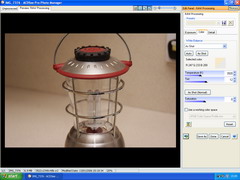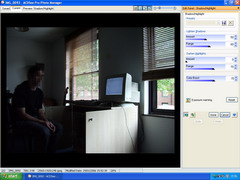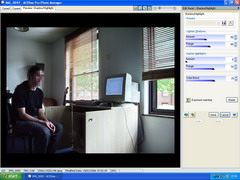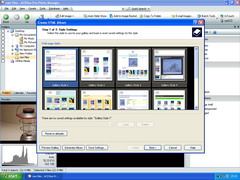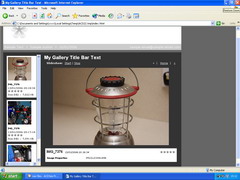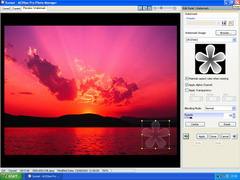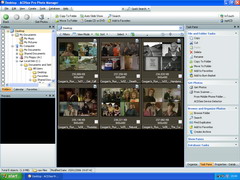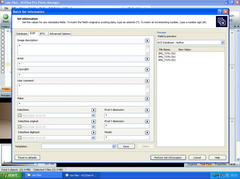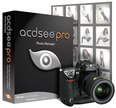 ACDSEE PRO NOTE: THIS IS ONLY AN ADDENDUM TO OUR FULL REVIEW OF IMAGE MANAGEMENT TOOLS UPDATED JANUARY 31st, 2006 review by Nudone |
|||
INTRODUCTORY WORDS FROM NUDONE, THE REVIEWER:
"I’ve been using the Beta version of ACDSee Pro for a few weeks now, and before that, I was using the standard non professional flavour of the program (that’s just a plain old version 8). I mention this as it would be sensible to compare the latest release against the old version 7 that was favored in the DonationCoder.com ‘Image Management Shootout’, the problem is that I can hardly remember using the previous edition.
A brief glance at the new interface and you would be forgiven in thinking that the past few months have not brought many changes to the program. The layout has obviously fallen into a comfy groove – buttons and panes appear in the same places as before, menus feel the same, but don’t let this familiarity fool you into thinking there is nothing new.
I recall that when version 8 appeared it seemed like a minor improvement on the previous version, just a few tweaks and upgrades that didn’t stand out as anything major although they were welcome improvements (the quick search bar sure was handy and the return of the favorites panel was good to see). The professional version may seem even less of leap forward from the standard 8 release but I think that this may just be a bias that I now carry with me because I remember the dramatic changes the earlier versions of ACDSee went through – from around version 3 up to around version 6, ACDSee seemed to be going through an adolescent identity crises, warping from one style of interface to another with each release. The stability of ACDSee’s current appearance perhaps then shows there is a maturity to the program now – it’s comfortable with its looks and doesn’t feel the need with any more experimentation. And, standardization can be a good thing as the users that keep upgrading the program needn’t keep relearning where things have been moved to with each new release.
But what of the new pro version – is it strictly for a more serious kind of user or are we all invited to the party?"
![]()
A MORE COMPLETE EXPERIENCE
ACDSee Pro feels like the most complete and satisfying version of the program so far. It may still not have everything you could possibly dream of for a ‘professional’ photo manager but you can see that ACD Systems are now in the fast lane and know where to head. Something like Adobe Bridge still has greater compatibility with image formats at the pro end of the scale but ACDSee is quicker to work with for the things it will do and is easier to use as a viewer, quick editor and media manager. I have the luxury of being able to use Adobe Bridge but the time it takes to load up and do anything with (even on a high spec pc) just makes me automatically click on ACDSee instead.
The pro in the software’s title largely means that you can now comfortably follow a photographer’s standard work path: from selecting the right RAW image files from your camera, tweaking them a little, comparing up to four of them at a time on screen and then running a batch process on the ones you’ve singled out to use. If you’re regularly taking a lot of photos with a digital SLR camera then I’m sure you’ll appreciate what ACDSee Pro is offering.
An extension to the interface comes into play when RAW files are detected in the browser which will then allow you to make several adjustments to your photos. These adjustment settings can be saved for later use, either with batch processes or even as part of ACDSee’s database so that a particular RAW file will remember the adjustments you made to it (note that RAW files are not modified until you save them out as a different file type, i.e. jpeg or png).
Other highlights that are aimed at the ‘pro’ user are the abilities to watermark your images (graphically and/or by text) and the support for color management when working with images that contain ICC or ICM profiles. These may not attract the average user wanting to manage their image collection but there are several other features that will possibly sound tempting…
![]()
CUSTOM WORKSPACES
Workspaces can be arranged, named and saved so that you can quickly set out your most productive layout depending on the job in hand (the snap to location helper that appears when moving the panels around is a nice little feature that takes out the guess work when rearranging things). Keyboard shortcuts are always handy and time saving, even more so when you can set your own for pretty much any command there is. This can be especially useful as you may not always see the button(s) you want if the workspace you’ve chosen has temporarily hidden away some functions. Admittedly, you’ll have to make the effort to remember these quick key commands but in the long run you’ll benefit from it.
IMAGE ADJUSTMENTS
There is hardly a time that a photograph doesn’t require a little help from adjusting its levels, but now you can push truly terrible underexposed images in the right direction by using the Shadow/Highlight tool. This is another welcome addition to the large array of filters/tools already present from version 8 but it is probably the most useful for everyday photo tweaking. Just think of it as an ‘intelligent’ auto levels machine. (For anyone not used to working with levels on their digital photographs you really need to see the before and after improvements you’ll get when you use this kind of tool – it’s almost essential for everything you’ll do.)
Common lens distortions can be corrected. This will aid the professional photographer that wants the perfect image but it may be of even greater use for those using mobile phone cameras and less professional lenses. Close-up snaps taken with a handy mobile phone can often suffer from a fish-eye bulging appearance, so if you want your super quick snaps to look like they were taken with better equipment then ACDSee Pro is something to consider again. (Okay, maybe it’s just me that snaps photos with a mobile phone camera a few inches away from the subject but the method applies to almost all cameras – perspective distortions are probably the most noticeable and common problem found in photography).
COOL TOOLS
An improved web page generator is included – several appealing templates can be selected and previewed before actually generating the pages. These are akin to lightbox galleries for demonstrating your portfolio of work with automatic insertion of filenames and image properties. This probably isn’t what you’d go for if you just wanted to upload your family album but it’s nice to provide an alternative (if you’ve got a web host) to the free services that are provided online like Flickr.com, etc.
And as a bonus, ACDSee makes a great ‘media’ file manager. If you do a lot of video editing on your pc then you’ll probably find the way ACDSee lets you view thumbnails of videos and the segment looping feature very useful when you are picking out clips to edit. The video thumbnail preview is the best I’ve seen as it doesn’t just take a snapshot of the first few frames of the clip, which are usually black, but instead extracts four frames from much further into the file which are often easier to identify). ACDSee can be a great compliment to tools like Adobe Premiere in this respect.
![]()
STILL SOME LINGERING IMPERFECTIONS..
There are still imperfections in the program, perhaps the most serious being the below average image printing features, which is a real shame for a program of this caliber.
The development team appears to have abandoned working on the printing options in ACDSee several versions back; this complete neglect makes you wonder just how new version of ACDSee will fair in this area. Integrating ACD Systems ‘FotoSlate 4’ printing software directly into ACDSee would be obvious solution. For the Pro version of ACDSee to become a true ‘start to finish’ digital workflow piece of software then it really needs to sort out the printing options on offer.
Currently, with a bit of time, you can save your own templates for various contact sheet type arrangements and being able to add metadata that you may require is certainly a powerful and useful feature in a professional working environment. The problem is simply that you’ll want to print images in the regular non contact sheet fashion and this is where ACDSee just doesn’t deliver – the ‘full page’ options are minimal to say the least. If you want the print ‘space saving’ options found in many other image management programs then you aren’t going to satisfied here. It’s clear that ACD Systems know what the user wants as they’ve provided it with FotoSlate – the question remains: how professional is ACDSee Pro when half of the printing options have been left out and put into a completely separate piece of software.
Another concern is that jpeg2000 files with the extension .jpf are still unable to be viewed by ACDSee; Adobe Bridge views them without exception. This may not trouble the majority of users but it illustrates that there are still fundamental problems with the program – what use is a ‘professional’ photo manager that can’t read a common image format. It really ought to cover every single image type there is by now.
We hope that ACDSee spends more time improving these points in the future.
![]()
ACDSEE *PRO* IN PICTURES
Click on the thumbnail images for full-sized images
![]()
FINAL WORDS - IS IT WORTH PURCHASING?
In our original review of Power-user Image Management Tools, we recommended ACDSee version 7 and the freeware program XnView. In this addendum we have taken a look at the new ACDSee Pro.
Overall, this is the best ACDSee there has been and that automatically makes it the best image manager available today. Version 7 was ahead of the pack in terms of features and now the leader has gained pace and raced even further away from the group of other programs you may like to compare it with. So, a great program has definitely got better, but is it good enough when you look at the price you’ll have to pay?
If you’ve favored the freeware image manager programs in the past then there's nothing in the Pro version that's likely to change your opinion, and existing ACDSee users who are happy with their current version may find little reason to upgrade to the Pro edition.
But while ACDSee 8 is more than good enough for the average user, if you are hooked on your digital SLR and want the best kind of workflow I’ve seen in an image manager program (especially for RAW files) then the professional edition is something you’ll love. Although the pro version is over twice the cost of the standard version 8, if you earn your living from working with photographs or are just really into digital photography as a hobby, then the $130 price tag is easy to swallow – you’ll be accustomed to spending far more than that on camera equipment already.
However there is a slight conundrum with this new professional release – The ‘pro’ in the title and the features the program boasts are aiming at users that are very likely to own Adobe Photoshop. These users will most likely already have Adobe Bridge installed, so will they have good reason to swap over to ACDSee Pro?
The answer is a qualified 'yes'. ACDSee Pro is easier and faster to work with. You may not use all of the filters and restoration tools that are built into it but the batch processing and ease of navigation around your image collection and the fantastic methods of quickly labeling/categorizing files are the features that we all love about the program. And for those of you dabbling with digital photography and feeling you want a brilliant way of organizing and adjusting your photo collection, then, you really should install a trial version of ACDSee and give it a good test run, and for those who have been dreaming of a better RAW file manager (at least, better than the software you get with most cameras), ACDSee Pro may be exactly what you need.
|
CLICK HERE TO RETURN TO THE MAIN REVIEW OF IMAGE MANAGEMENT TOOLS |
|||
review by Nudone 

 Discuss This Review
Discuss This Review



